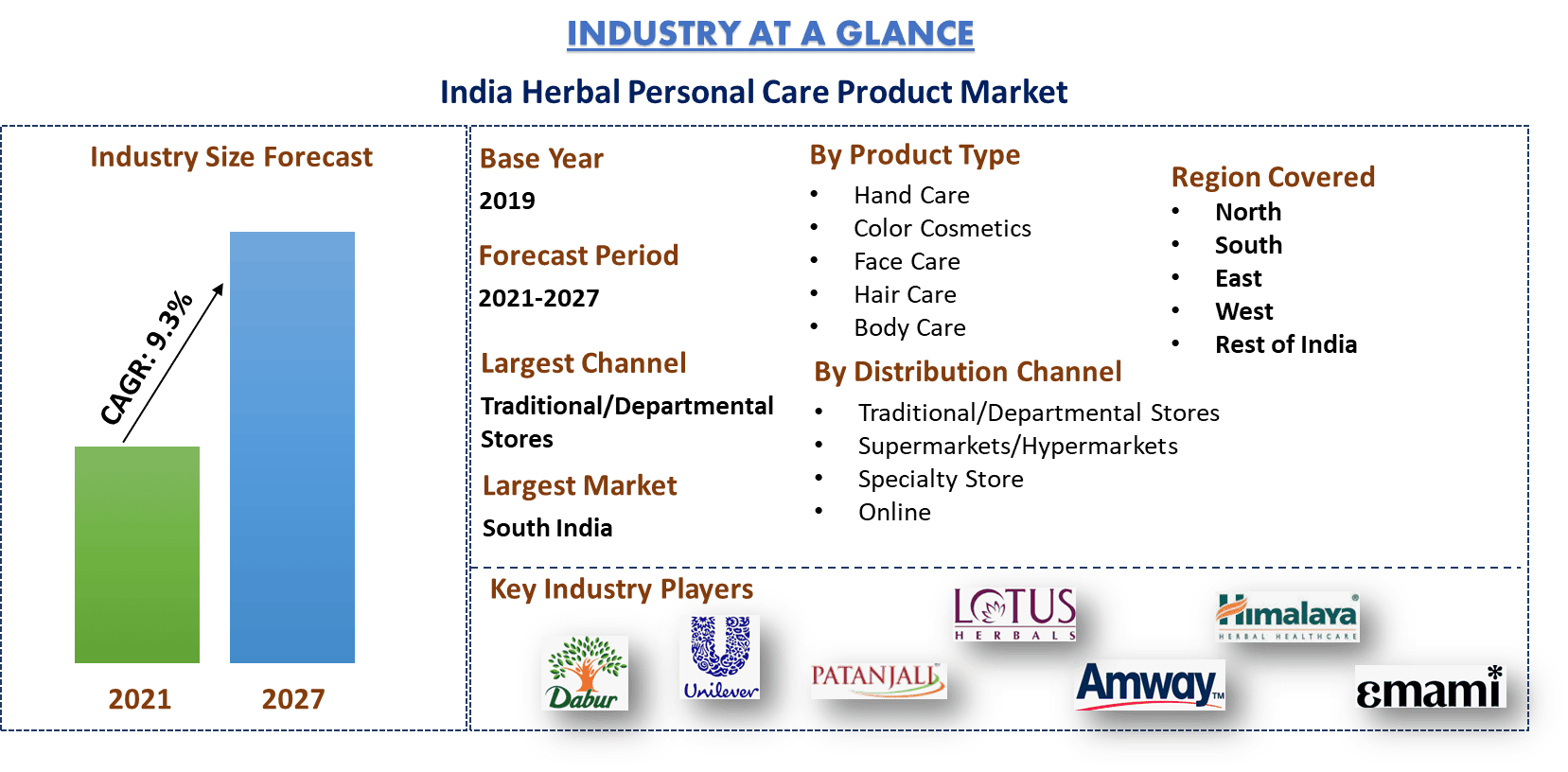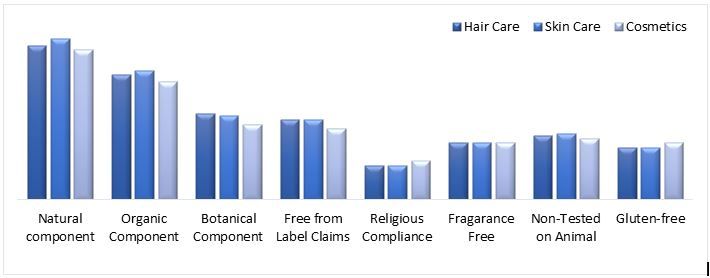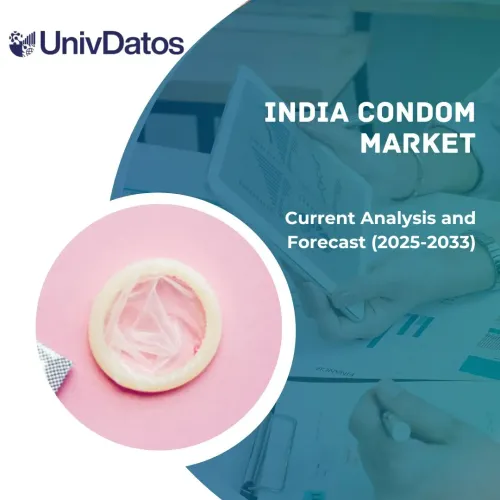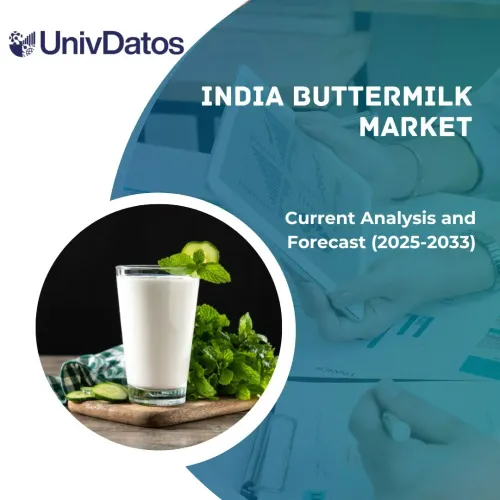- Home
- About Us
- Industry
- Services
- Reading
- Contact Us
India Herbal Personal Care Product Market: Current Analysis and Forecast (2021-2027)
Emphasis on Product Type (Hand Care, Color Cosmetics, Face Care, Hair Care, Body Care, Others); Category (Mass, Mid-Premium, Premium); Distribution Channel (Traditional/Departmental Stores, Supermarkets/Hypermarkets, Specialty Stores, Online); and Regions

Consumers shift towards the adoption of herbal personal care products over synthetic products owing to the rising awareness about different products driving the India Personal Care Products Market. Rising awareness about the side-effects on health and body from chemicals such as sulfates, fragrances, parabens; etc., present in the conventional personal care products such as skincare, haircare, body care, and other such products, has inclined consumer’s interest towards the herbal personal care products. This has been the major driving factor for the market growth. Moreover, the younger generations are quite familiar with new developments and health benefits from herbal products in the beauty and personal care market. Furthermore, consumers are becoming more aware regarding animal welfare and are trying to avoid personal care products which involved harming animals in any way, which has also majorly affected the shopping behavior of the consumers.
As people become more aware of the potential dangers of using chemical formulations, they turn to ‘safer’ herbal and Ayurvedic products like Himalaya, Biotique, Dabur, Lotus, Patanjali, and others, herbal cosmetics products are driving development. Many Indian and international brands have launched multiple products across categories to take advantage of the existing player role in this market. Super-premium and luxury brands such as Shahnaz Hussain, Forest Essentials, and Kama Ayurveda have all launched products in this space in response to growing demand.
Consumerism’s evolution has had a huge impact on the economy. Consumers may be classified as loyalists or experimenters based on their purchasing habits and frequency. These days personal care items are purchased online mostly due to product standardization, sales, and promotions on different websites, while mid-premium and premium+ products are purchased in offline retail stores because the customer mindset still believes in the product’s “touch and feel.”
Consumer Preferences For Personal Care Products
Patanjali Ayurveda Ltd, Dabur Limited, The Himalaya Drug Company, Amway, Lotus Herbals Private Limited, Emami, Godrej Consumer Products, Palmolive, Unilever Group, and Johnson & Johnson are some of the prominent players operating in the Indian Herbal Personal Care Product Market. Several M&As along with partnerships have been undertaken by these players to facilitate customers with hi-tech and innovative products.
Insights Presented in the Report
“Amongst product type, face care segment holds the major share”
Based on the product type, the market is fragmented into Hand Care, Color Cosmetics, Face Care, Hair Care, Body Care, and Others. The face care segment dominated the market with a share of XX% in 2020 and is expected to maintain its dominance during the forecast period owing to the increasing demand for more natural products in cosmetics for makeup, shaving products; etc. in the market.
“Amongst category, the premium is anticipated to grow at the highest CAGR during the analyzed period”
Based on category, the market is fragmented into Mass, Mid-Premium, and Premium. In 2020, the Mass segment accounted for a maximum market revenue share of XX% and is expected to remain dominant during the analyzed period. However, the market is moving towards the premium segment and is anticipated to grow at the highest CAGR over the forecast period and reach a market evaluation of USD XX billion by the year 2027.
Amongst distribution channel, the traditional & departmental stores segment holds the major share”
Based on the distribution channel, the market is studied into Traditional/Departmental Stores, Supermarkets/Hypermarkets, Specialty Stores, and Online. The traditional & departmental stores dominated the market in 2020 with revenue of USD XX billion and is anticipated to maintain their dominance during the analyzed period. Furthermore, the online segment is expected to grow at the highest CAGR during the period.
“South India signifies one of the largest markets of India Herbal Personal Care Product Market”
For a better understanding of the market dynamics of the Herbal Personal Care Product Market, a detailed analysis was conducted for different regions across India North, East, West, South, and the Rest of Indian regions. South India dominated the market and generated revenue of USD XX billion in 2020 owing to the increasing awareness about the side-effects of synthetic products accompanied by high disposable income and an increase in per capita spending of the consumers in the region.
Reasons to buy this report:
- The study includes market sizing and forecasting analysis validated by authenticated key industry experts
- The report presents a quick review of overall industry performance at one glance
- The report covers an in-depth analysis of prominent industry peers with a primary focus on key business financials, product portfolio, expansion strategies, and recent developments
- Detailed examination of drivers, restraints, key trends, and opportunities prevailing in the industry
- The study comprehensively covers the market across different segments
- Deep dive regional level analysis of the industry
Customization Options:
India Herbal Personal Care Product Market can further be customized as per the requirement or any other market segment. Besides this, UMI understands that you may have your own business needs, hence feel free to connect with us to get a report that completely suits your requirements.
Table of Content
Analyzing the historical market, estimation of the current market, and forecasting the future market of the Indian Herbal Personal Care Product Market were the three major steps undertaken to create and analyze the adoption of Herbal Personal Care Product for different purposes across major regions globally. Exhaustive secondary research was conducted to collect the historical market numbers and estimate the current market size. Secondly, to validate these insights, numerous findings and assumptions were taken into consideration. Moreover, exhaustive primary interviews were also conducted, with industry experts across the value chain of the Herbal Personal Care Product sector. Post assumption and validation of market numbers through primary interviews, we employed a top-down/bottom-up approach to forecast the complete market size. Thereafter, market breakdown and data triangulation methods were adopted to estimate and analyze the market size of segments and sub-segments the industry pertains to. Detailed methodology is explained below:
Analysis of Historical Market Size
Step 1: In-Depth Study of Secondary Sources:
Detailed secondary study was conducted to obtain the historical market size of the Herbal Personal Care Product through company internal sources such as annual report & financial statements, performance presentations, press releases, etc., and external sources including journals, news & articles, government publications, competitor publications, sector reports, third-party database, and other credible publications.
Step 2: Market Segmentation:
After obtaining the historical market size of the Herbal Personal Care Product Market, we conducted a detailed secondary analysis to gather historical market insights and share for different segments for major regions. Major segments included in the report are product type, category, and distribution channel. Further country-level analyses were conducted to evaluate the overall adoption of Herbal Personal Care Product in every region.
Step 3: Factor Analysis:
After acquiring the historical market size of different segments and sub-segments, we conducted a detailed factor analysis to estimate the current market size of Herbal Personal Care Product. Further, we conducted factor analysis using dependent and independent variables such as the shift towards organic-based cosmetics, rising awareness about health benefits from organic products, growing demand for innovatively packaged cosmetics, etc. A thorough analysis was conducted for demand and supply-side scenarios considering top partnerships, merger and acquisition, business expansion, and product launches in the Herbal Personal Care Product industry across the globe.
Current Market Size Estimate & Forecast
Current Market Sizing: Based on actionable insights from the above 3 steps, we arrived at the current market size, key players in the Herbal Personal Care Product Market, and market shares of the segments. All the required percentage shares split, and market breakdowns were determined using the above-mentioned secondary approach and were verified through primary interviews.
Estimation & Forecasting: For market estimation and forecast, weights were assigned to different factors including drivers & trends, restraints, and opportunities available for the stakeholders. After analyzing these factors, relevant forecasting techniques i.e. top-down/bottom-up approach was applied to arrive at the market forecast about 2027 for different segments and subsegments across the major markets globally. The research methodology adopted to estimate the market size encompasses:
- The industry’s market size, in terms of value (USD) and the adoption rate of Herbal Personal Care Product across the major markets domestically
- All percentage shares, splits, and breakdowns of market segments and sub-segments
- Key players in the India Herbal Personal Care Product Market in terms of services offered. Also, the growth strategies adopted by these players to compete in the fast-growing market
Market Size and Share Validation
Primary Research: In-depth interviews were conducted with the Key Opinion Leaders (KOLs) including Top Level Executives (CXO/VPs, Sales Head, Marketing Head, Operational Head, and Regional Head, Country Head, etc.) across major regions. Primary research findings were then summarized, and statistical analysis was performed to prove the stated hypothesis. Inputs from primary research were consolidated with secondary findings, hence turning information into actionable insights.
Split of Primary Participants in Different Regions
Market Engineering
Data triangulation technique was employed to complete the overall market estimation and to arrive at precise statistical numbers of each segment and sub-segment of the Herbal Personal Care Product Market. Data was split into several segments & sub-segments post studying various parameters and trends in the areas of product type, category, and distribution channel of the Herbal Personal Care Product Market.
Main Objective of the Herbal Personal Care Product Market Study
The current & future market trends of Herbal Personal Care Product were pinpointed in the study. Investors can gain strategic insights to base their discretion for investments from the qualitative and quantitative analysis performed in the study. Current and future market trends were determined the overall attractiveness of the market at a regional level, providing a platform for the industrial participant to exploit the untapped market to benefit as a first-mover advantage. Other quantitative goals of the studies include:
- Analyze the current and forecast market size of Herbal Personal Care Product in terms of value (USD). Also, analyze the current and forecast market size of different segments and sub-segments
- Segments in the study include areas of product type, category, and distribution channel
- Define and analysis of the regulatory framework for the Herbal Personal Care Product industry
- Analyze the value chain involved with the presence of various intermediaries, along with analyzing customer and competitor behaviors of the industry
- Analyze the current and forecast market size of the Herbal Personal Care Product Market for the major region
- Major regions studied in the report include North, West, South, East, and Rest of India
- Company profiles of the Herbal Personal Care Product Market and the growth strategies adopted by the market players to sustain in the fast-growing market
- Deep dive regional level analysis of the industry
Related Reports
Customers who bought this item also bought












